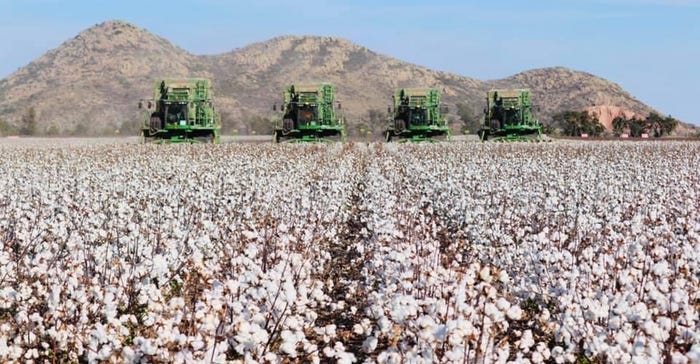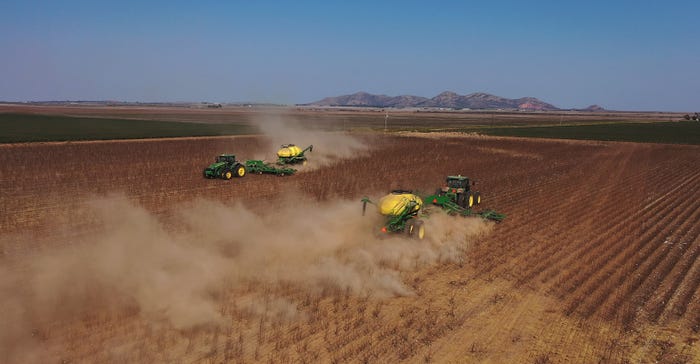
The worms are back in the Miller’s cotton fields — the good kind, earthworms, testament to healthier soil.
Boone Miller, who depends on cotton on his Jackson County, Oklahoma farm, credits a combination of no-till planting and winter cover crops for building up the organic matter that attracts earthworms.
“I see a lot of earthworm activity,” Miller said. “When we get a little rain, we see a lot of them. Back in May and June, we couldn’t dig in a trench without finding a worm.”
“The Miller Farm is a family operation,” Boone said. “My dad, Tim, my mom, Jerri Lynn, my brother Blaze, his wife, Martha, and my wife Morgan are all in the operation equally.”

Miller Family, from left, Mason, Boone, Bo Paige, Morgan, Blakely; Jerri Lynn and Tim; and Martha and Blaze.
They’ve been planting cotton no-till since 2008. “We plant back in the same rows every year. After harvest, we just run the shredder. We’re picking up some organic matter from shredded stalks and from winter cover. Organic matter is improving but it takes time to see big gains.”
The winter cover crop, Miller said, helps build organic matter, limits soil erosion, and offers rotation value for cotton.
See, Cover crops: What to consider
“We plant cotton on every acre and sow wheat or other grains behind cotton,” he said. “I terminate the grain.”
The Miller operation planted mostly wheat and rye and some barley this year. “We’ve been planting a grain winter cover crop since about 2013, seven years on a consistent basis.”
Cover advantages
Miller said cotton offers the best profit opportunity for his farm. “With our soils and farm practices, we couldn’t make enough grain to justify planting it for harvest. We grow as much cotton as we can. We can make a little profit with cotton; some years it’s hard to break even with wheat.”
He hasn’t worked with multiples cover crop species. “We are limited on what we can sow for cover.”

Moisture is an issue. Southwest Oklahoma tends to be on the dry side, and with limited moisture, taking a grain crop to harvest or adding a multi-species cover crop mix, increases water demand.
“We’ve tried rye, but landlords are not fond of rye, which can be bad in wheat. We planted some barley this year, got it up and going. It matures faster. This is the first time for barley, so I can’t say lot about it yet. We might plant it again next year. That’s the plan.”
He said rye has advantages. “On sandy soils, rye is superior for cover. It provides more cover.”
Termination
Terminating the cover crop can be a tricky issue. On one hand, Miller said he needs enough biomass to protect the soil and add organic matter. On the other hand, waiting longer takes more moisture out of the soil profile.
“When the cover crop gets to hollow stem, it can last a lot longer into the season. If we don’t get moisture after that point, we have less moisture in the soil profile for planting.”
He said the winter cover benefits cotton. “Starting off, we get a longer window to plant. In cotton behind cotton with no cover, it’s often too dry to plant. With the grain residue, the moisture seems to last. Also, cotton seems to hang on a little longer when we get into a drought.”
After the cotton develops a canopy, the cover crop residue helps keep soil temperatures lower in a hot summer.”
He says harvesttime can be hectic as he tries to plant small grain behind the harvester.
“We tried inter-seeding, planting small grain into the cotton rows in August or September. That doesn’t work well with cotton. Planters cut off limbs and we lose bolls. Inter-seeding was hurting cotton too much. We seed everything after harvest, no-till with a John Deere 1890.”
They don’t pant grain for harvest and set seeding rate accordingly. “Seeding rates range from 80 pounds to as low as 20 pounds,” Miller said. We like 20 to 30 pounds with wheat and rye. That still helps control erosion. At ten-inch spacing, those close rows make up lot of difference. We’re holding moisture better, and if we get enough growth, we hold soil in high winds.”

Seeding a small grain cover crop begins right behind cotton harvest for the Jackson County, Oklahoma, Miller Farm.
In early November, the Miller farm was well into cotton harvest and sowing small grain. “We’re 30 percent done harvest and 20 percent done sowing cover,” he said. He likes to be through planting as early as possible. “But we have sowed into January and were still okay. We had enough cover to hold the soil. We don’t like fighting sand.”
Other voices
Oklahoma State University Extension cotton specialist Seth Byrd said cover crops are becoming more common across the region. “They might not be planted for the same benefits that are touted in other areas.”
He said many producers, like the Millers, plant winter cover to prevent soil losses, water and wind erosion, off-season. “Producers are planting small grains to prevent wind erosion.”
He agreed with Miller that moisture can be a concern.
“Many are terminating earlier to conserve limited moisture.” He said early termination is especially important for dryland cotton. “Even with irrigation, it is always best to limit moisture loss as much as possible.”
He said cover crops offer agronomic advantages, including increasing organic matter.
“We can see some advantages with weed control, but we also have some concerns. We need biomass to shade out weeds, and cover crops need to have time to grow the biomass, which uses moisture. We get weed suppression with cover crop residue and that takes some pressure off herbicides; in reduced tillage situations, we depend more on herbicides.”
Termination timing is a key, Byrd said. “We’ve been looking at research that was done before cover crops gained popularity. Small grains are the most common here. We’re looking at some mixes with cereal rye, wheat, and barley, which could be a good fit. Barley matures early, so producers can terminate early and still retain biomass.
“Termination and preserving moisture for the next crop is a balancing act.”
OSU agronomist Todd Baughman offers another concern with cover crop and weed control. “Some cover crop mixes may limit herbicide use since herbicides that take out marestail and other tough weeds are hard on legumes. Producers need to think about what weed targets they have.”
He cited moisture as the biggest concern. “Trying to make two crops in a year on too little rain to make one crop is tough.”
Ha agreed that weed control and moisture retention with a cover crop is a balancing act. “Rye, for instance, needs to get high enough to produce enough biomass to suppress weeds, and producing that biomass is when it needs most moisture.”
He said rye could be a better option for marestail, Russian thistle and cochia, which can be troublesome in cover crops.
Crop situation
Miller said the 2020 crop might turn out fair. It had its troubles, including an ice storm in late October. “We lost some cotton; the storm knocked some on the ground. Bale weights were going down compared to before the ice. August hurt us, too. We had no measurable rain in August.”

He anticipates yields from 400 pounds at the low end to pushing two bales at the top. “It doesn’t look terrible,” he said. “Grades have been good. But a good rain in August would have made it one for the record.”
About the Author(s)
You May Also Like






